An important period of the historical development of garden art: “Renaissance garden style”
Bahçe sanatının tarihi gelişiminde önemli bir dönem: “Rönesans bahçe üslubu”
Abstract
Having a place in the concept of landscaping, which is an important factor in human life for integration with nature, garden art has shown a continuous development since its formation back in history. The first examples of garden styles in history were shaped with the effects of religious, philosophical, and mythological ideas. As in all branches of fine arts, garden art is nurtured by historical insights of style, and the reflections of cultural heritages are visible in all the designs that appear. It can be understood that the basis of the professional and modern garden designs is the historical gardens, and they show a development in that direction.
In order to establish and document the historical formation and development processes of garden art, initially a definition of the concept of garden was made and the historical development of garden art was examined within the garden art styles of Antiquity, Middle Ages, Far East, Islamic, and British periods, in the research forming this study. After that, the Renaissance period garden style, meaning ‘rebirth’, which forms the detail of this study is examined with its historical development, its characteristics, and samples, in detail.
Keywords: Style, Landscape, Garden art, Historical gardens, Renaissance.
Özet
İnsan yaşamında doğa ile bütünleşme için önemli bir faktör olan peyzaj kavramında yer alan bahçe sanatı, çok eski tarihlerdeki oluşumundan itibaren sürekli gelişim göstermiştir. Tarihte ilk bahçe üslubu örnekleri; dini, felsefi ve mitolojik düşüncelerin etkileri ile biçimlenmiştir. Bahçe sanatı, güzel sanatların tüm dallarında olduğu gibi tarihi üslup anlayışlarından beslenmekte ve ortaya çıkarılan tasarımlarda, hep kültür miraslarının yansımaları görülmektedir. Günümüzde oluşturulan profesyonel ve modern bahçe tasarımlarının temelinin de tarihi bahçelere dayandığı bu doğrultuda gelişme gösterdiği anlaşılmaktadır. Bu çalışmamızı oluşturan araştırmamızda, bahçe sanatının tarihsel oluşum ve gelişim süreçlerini belgelemek üzere öncelikle bahçe kavramının tanımı yapılmış ve bahçe sanatının tarihsel gelişimi; İlk Çağ, Orta Çağ, Uzakdoğu, İslam ve İngiliz dönemlerinin bahçe sanatı üslup anlayışları ile detaylı olarak irdelenmiştir. Sonrasında ise çalışmamızın detayını teşkil eden, yeniden doğuş anlamına gelen Rönesans dönemi bahçe üslubunun; tarihsel süreç içerisindeki gelişimi, özellikleri ve örnekleri detaylı olarak irdelenmiştir.
Anahtar Kelimeler: Üslup, Peyzaj, Bahçe sanatı, Tarihi bahçeler, Rönesans.
Introduction
The notion of style is defined as the way of doing a job, containing the technique and way of working related to a period, or a country. In the field of art, it is defined as the authentic way of designing of an artist, a kind of art, or a period of art. This notion having a place in architecture and art, and being used, has been realized since the beginning of the XIII. Century. Following this period, the term style began to gain a meaning as the way and authenticity of an artist expressing himself in the garden art as well.
The Turkish word for garden, ‘bahçe’ comes from Persian meaning ‘small vinyard’, and defines green spaces designed by humans, having a visual quality, containing various kinds of plants, and many constructional elements (Demiröz, 2002). Gardens are spaces shaped by the physical-geographical characteristics they are in, the living conditions, cultures, and economic situations.
Through the historical process, gardens have gained importance by being a part of daily life, in which people can establish a contact with nature, relax, and feel calm and pleasant. Having a great place in living areas in settlings, which came into existence with permanent settlements, gardens have appeared as open spaces designed to meet the physical and mental needs of people Çetinkaya & Uzun, 2014).
According to Mcintosh (2005), garden art is defined as a way of reflecting an idea, a thought, and a philosophy of life (Şişman & Gültürk, 2015). Garden art designs are planned in a way to express a certain life culture, philosophy, conditions of a period, and a belief. The first examples of gardens in history are seen in antiquity, in Egypt, Persia, Ancient Greece, and Ancient Rome. Most of the examples of gardens from that period did not reach the present because the materials used in their designs were not durable and of a low quality, disappearing in time. These gardens can only be perceived through walls, pottery, canvas paintings, reliefs, and through written orations.
The Renaissance garden art was designed in a way to meet the needs of people to have a nice time, relax and meet their vital needs, with the understanding of getting close to nature and integrate with it. Serving only the aristocracy and the royals initially, in time these gardens were open to public use and gained a quality as public green spaces. The Renaissance garden style have affected the concept of garden art in Europe and in many other countries in the world through the historical process.
Starting with the birth of humanity, at a very small scale, the art of garden designing has shown positive and negative developments in time, and has affected the appearance of the notion of grand scale landscape planning (environmental organization) of the present. This field of art continued its development in the last half a century, and has turned into urban and rural landscape planning at country level.
It is of great importance to know and understand the formation and development of garden styles throughout history as they form a basis for the present day garden designs. Therefore, this study, which examines the qualities and examples of garden styles beginning in the Antiquity, is of importance for providing information about the relations and differences among gardens of different periods.
This study aims at examining the Renaissance garden art examples in detail, based on the formation and development of garden style throughout historical periods up to the present day. The scope of the study is comprised of the historical development of garden art, and the formation and development of Renaissance garden art.
Methodology
This study is composed of a detailed examination of Renaissance garden art, which was an important period for the formation and development of garden art that appeared in various styles throughout history as green spaces became areas in which people became one with nature and met their physical and psychological needs. The study was carried out using the qualitative research method. Literature review was carried out with the aim of obtaining historical knowledge and visuals on the subject.
The study initially defined the concept of garden and historical formation and development of garden art was analyzed chronologically. Starting with antiquity, style concepts of garden arts of the Middle Age, Far East, Islamic, and British period were examined.
Renaissance Garden Art, with its apprehension of approaching nature and integrating with it, which is the main subject of this study, was studied under the headings of Italian Villa Gardens and French Grand Style Gardens since its appearance with the Renaissance style in the Middle Ages, and samples of villas and palaces with the characteristics of garden art under each heading, were examined in detail and supported with visuals. The effect of French Baroque gardens on Europe and other countries were also illustrated with palace gardens from Germany, Russia, Holland, Portugal, and Turkey.
An important period in history, Renaissance Garden Art, during which open green spaces - besides indoor places - appeared and showed development, was documented in this study with its characteristics. Thus, a source for reference was created for future scientific studies.
Garden Art in History
The notion of garden is defined as living space intensely used by people to meet their needs for resting and entertainment (Gültekin, 2001). It is believed that at the beginning of the formation of gardens, people adhered to religious, philosophical, and mythological ideas, and they formed their gardens inspired by these ideas. Nondurable materials, such as brick, wood, and plants were used in the formation of these living spaces, which prevented their survival to the present day. At present, we can only attempt to learn about these works and interpret them from paintings on walls and pottery, and from written works. In addition, recent archeological works brought to light garden samples that are almost intact (Yerli & Kaya, 2015).
It is known that the formation and development of landscape planning dates back to pre-historic times. During those times, people formed their living spaces in nature, and they shaped these spaces to meet their needs. Having limited tools, and their needs and objectives being at a partial scale, prevented nature getting destroyed at great levels. Small scale environmental arrangements, which started with first settlements, showed development with positive and negative contributions through the historical process, and enabled the formation of large scale landscape planning at present (Korkut et al, 2010). The formation and development of garden art during the historical process can be shown in chronological order below:
Garden Art in Antiquity
As people left nomadic life and moved into permanent settlements, agricultural activities increased. Using water properly and life developing in harmony with nature brought about the first examples of gardens. Samples of gardens from the Antiquity are seen in Mesopotamia, Egypt, Iran, Ancient Greece, and Ancient Rome (Korkut et al., 2010).
Garden Art in the Middle Ages (Middle Ages European Gardens)
The Middle Ages being a period of wars and plagues, cities were surrounded with protective walls, thus castle seniorages, city states, and feudality type administrations appeared. Towards the end of the Middle Ages, life overflowed out of the walls with the increase in populations. However, these settlements were also planned with narrow streets, concentrated and far from green spaces because of safety concerns and economical inadequacies. The green spaces within these settlements were mostly created in the empty places among houses for agricultural produce, and fruits, vegetables and medicinal plants (Korkut et. al., 2010). Two main streams, Roman and Gothic art were effective in European garden art in the Middle Ages. Cathedral, monastery, and castle gardens are examples showing the characteristics of these styles (Dinarlı, 2014).
Far East Garden Art
Far East gardens comprise the Chinese, Japanese, Mongolian, and Indian garden arts. These gardens were considered as symbols of the peaceful life of people, as part of the love and yearning for nature of the Far East people, and were designed accordingly. The Chinese garden art of this era became a source of inspiration for the European gardens which showed a change in the XVIII. Century. The art of designing flowers (ikebana) and the art of growing midget trees (bonsai) arose in the Far East garden art. These art movements came to life in China and showed development in Japan (Korkut et. al., 2010).
Islamic Garden Art
Islamic garden art was founded in geographies of Turks, Iranians, Spanish, and Arabs, where the Islamic religion spread, and developed through interaction with the cultures and art philosophies of the people living there (Nevoku, 2011).
British Garden Art
Naturalism is a movement of art which developed with the principles and methods of the perception of nature being implemented to literature and fine arts. Gardens, showing a development in the 18th century with a perception of naturalism, appeared as a reaction to the baroque garden art dominant in Europe. The style of naturalism, which affected garden art in almost all of Europe, initiated in Britain first. In this garden art, a style was featured in which human intervention was minimal and naturalism prevailed (Çetin, 2018).
Renaissance Garden Art
Conceptually, renaissance is explained as re-birth. Lasting about ten centuries, the Middle Ages, during which religious oppression, superstitions, and plagues prevailed, slowly began to leave its place to Renaissance towards the end of the 14th century. The Renaissance style, which appeared in Italy in the 15th century, contributed to branches of art such as music, literature, and painting in becoming professions (Dinarlı, 2014). One of the most significant effects of Renaissance was the development of the idea of loving nature and getting close to it, as opposed to the fear of nature which prevailed during the Middle Ages. The first Renaissance gardens appeared in the direction of this idea (Korkut et. al., 2010). Renaissance garden art can be examined and defined under two headings: Italian Villa Gardens, and French Great Style Gardens (Arseven, 1983; Hasol, 1993).
Italian Villa Gardens
Italian Villa Gardens were designed for the use of people; for relaxation and spending good time. These gardens were mostly created on hills because of climate conditions and for a good view of the scenery. They were made of water elements, stones, various plants, statues, and pergolas. Evergreen trees were used as plant elements with the aim of creating straight-line geometrical forms (Abdil, 2018). Italian Renaissance Gardens can be examined in three periods, based on their characteristics and development:
Florence Villas period (1450 - 1503):
The first architect of the Florence Villas period was Leon Bapsita Alberti, who was also an artist, a sculptor, and a musician. Alberti created many gardens during this period; unfortunately not a single sample survived to the present day. The main characteristics of these gardens are listed as below (Korkut et. al., 2010):
- Gardens were designed together with the architecture of the building, and placed in a position so that they could be perceived from every point of the building.
- Slightly slanted ramps were created to provide access to the garden.
- The gardens were opened to the surroundings through terraces with a wide view.
- Pergolas and canopies were created in the gardens.
- Ornamental pots with flowers were placed.
- Plants such as box tree and cone head thyme, pruned and given a shape took place in a visible part of the garden, with the name of the owner of the villa written there.
- Water element was used in a kinetic form.
- The garden was surrounded by high walls in order to provide protection.
The first samples of Renaissance villa gardens are seen in Italy, with some changes. Some of these gardens are Villa Medici, Villa Petraia, and Villa Castello. The characteristics of these garden samples are explained below (Figure, 3.1).
Villa Medici was created in a way that it harbored almost all the characteristics of the Italian garden style. Having a plain plan, the garden has a coherent relationship between the building and the environment. The connection among terraces in the garden was enabled with steps and wall terraces (Erdoğan, 2019).

Villa Mecidi plan.

Villa Mecidi.
Villa Petraia is a Renaissance villa built on a slanted plot. Opening to the environment gradually with three different terraces, there are different pools and evergreen plants on each terrace. One of the pools on the terraces is an octagonal marble one, another is a rectangular fish pool, and the one in the third terrace is a simple, circular marble pool with three levels (Erdoğan, 2019).
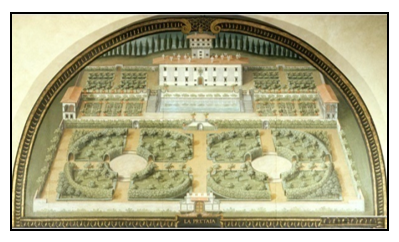
Villa Petraia plan.

Villa Petraia general view.
The garden of Villa Castello is made up of three terraces. The first two are surrounded by walls, and the third terrace is surrounded by botanical elements planted at specific intervals. A symmetrical design prevails in this garden, and there is a main axis with two parallel side axes. Besides various herbal elements, there are water elements and walls decorated with statues and reliefs in this garden (Erdoğan, 2019).
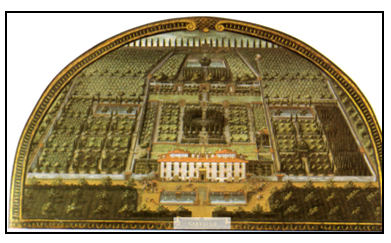
Villa Castello plan.
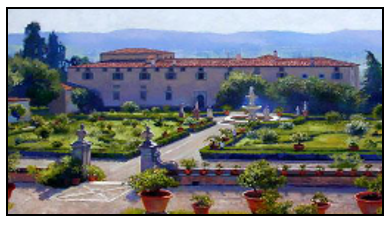
Villa Castello general view.
Figure 3.1. Garden art examples of period of Florence Villas (Dinarlı, 2014)
Period of Architects (1503- 1573):
Starting with the XVI. Century, villa gardens in Italy were re-shaped by architects. The main characteristics of these gardens created in this historical process, named the Second Renaissance, or Period of Architects, are given below (Dinarlı, 2014):
- Gardens covered great spaces in the plots they took place, and villas scattered around the gardens in sophisticated ways.
- Gardens were considered as architectural elements, and staircases, terraces, and walls were used widely.
- Classical statues were used widely, and the gardens became like open-air museums.
- The importance of the garden having a dominating view of the scenery gradually diminished.
- A ratio was used in the building-garden relationship.
- There is a central axis and symmetry in the gardens.
- The water element is used in a dynamic way in wide spaces.
- Evergreen plants are used in making walls to provide a background for the statues.
- The art of pruning and shaping botanical elements is used.
- Groves are created with the botanical elements.
The most prominent villa gardens formed in this period are Villa d’Este, and Villa Lante. The main characteristics of these garden samples are (Figure 3.2):
Villa Lante, was founded on a slope in Viterbo in Rome, in 1560. Showing the most significant example of garden art of the XVI. Century, there are water elements on terraces, stone tables, and botanical elements pruned and given shapes, in this garden. This garden, with a prevailing geometrical design, is the best protected Renaissance garden in Italy (Korkut et. al., 2010).
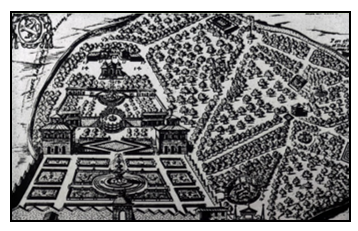
Villa Lante plan.

Villa Lante general view.
Villa d’Este was designed by Piero Ligorio in 1570s, one of the important architects of the period. This villa is in a place called Tivoli, near Rome. Created on a hilltop, there are evergreen plants, planted in a line alongside the road, and water elements in this villa garden. Water element is used as tiny brooks, sprinklers, ornamental pools, and fountains in the garden (Erdoğan, 2019).

Villa d’Este plan.

Using water element at Villad’Este.
Figure 3.2. Examples of garden art of Architects Period (Erdoğan, 2019)
Baroque period (1573- 1773):
The Baroque Period lasted for two centuries and was effective in the appearance of many unforeseen elements in art. In the Baroque period gardens the simplicity of Italian gardens was replaced with luxury and pomposity, and these spaces were opened to public use. With the relationship between building and garden diminishing during this period, it resulted in the connection between indoors and outdoors being broken.
Some of the important gardens of this period are, Villa Reale, Vila Garzoni, and Villa Albani. The main characteristics of Baroque period gardens are (Korkut et al, 2010), (Figure 3.3):
- Gardens are made of circular shaped squares and radial axes.
- Order and balance are dominant in the gardens.
- Besides geometrically shaped ornamental pools, water element is also used in the form of water canals in these gardens.
- Herbal elements are pruned to give them shapes such as, square, rectangle, sphere, triangle, cylinder, and pyramid.
- Plants in the form of trees and bushes are used in the function of statues.
- Flowering plants are planted in geometrically shaped flower beds.
- Labyrinths are created using evergreen plants.

VillaReale
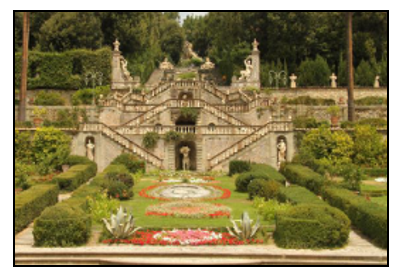
Villa Garzoni
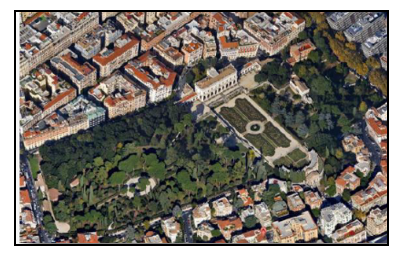
Villa Albani.
Figure 3.3. Examples of garden art at Baroq period (Dinarlı, 2014)
Grand Style French Gardens
The Hundred Year Wars between France and England, during the XV. Century resulted in the Renaissance arriving in France rather late. With the war coming to an end, French nobility began to show interest in the artistic developments in Italy, and were affected by the gardens they saw there when they visited. Likewise, in 1545, the French King Charles VIII. And later Louis VII. sent 21 French artists to Italy with the aim of observing these gardens and the Renaissance movements. On their return to France, these artists began to apply many artistic movements in France (Korkut et al, 2010).
One of the artists who played a great role in the development of garden art in France is Le Notre. He took an active part in garden planning for more than fifty years, and the students he trained helped garden style spread in some European cities (Erdoğan, 2019).
Andre Le Notre (1603-1700):
A famous landscape architect, Le Notre, was born in France, on March 12, 1603. Because of his background in architecture and art, he became the most important garden artist of the period. The garden arts Le Notre brought about were both reflective of French spirit, and had a different style; thus these details in his works created a new style. This style was named “The Grand Style”. The principles of this garden style are explained as follows (Erdoğan, 2019):
- The garden to be designed must be compatible with the terrain, and local climatic characteristics should be taken into consideration.
- There must be unity of scale and style between the building and the garden, and it should be suitable to the life style and financial status of the owners.
- The outlines of the garden should be simple; pomposity and variation should be shown in details.
- The garden should be planned to be shown larger than it is, and its length should be more than its width.
- The characteristics of the garden should be in harmony and balance with each other, and repetition should be avoided.
- Quite a lot of space should be given to statues. Water element should be used in wide spaces, without noise, and it should be given movement with sprinklers.
- The herbal elements should be pruned to achieve an order, and there should be wide spaces of grass.
The most important examples of gardens that Le Notre created in France are Vaux-Le Vicomte and Versailles palace gardens. The main characteristics of these gardens are:
Vaux-Le Vicomte Palace Garden
Vaux-Le Vicomte garden is of a quality that reflects the period in which Le Notre reached the peak of garden art. Built during the reign of King Louis XIV, it is known that at times 18,000 workers worked at the same time. The main aspects of this garden are (Korkut et al, 2010), (Figure 3.4):
- The garden area is rectangular in shape.
- The central axis dominating the garden divides the water surface into two, and it begins at the entrance of the palace and ends at a cave in front of a forest.
- Water element is used in pools in a still position, and sound and visual effects were provided with sprinklers.
- Boxwood and yew trees are pruned and given shapes, while beech trees are used as fencing.
- Citrus trees in pots are used in abundance.
- Flower beds are used in a symmetrical way, given geometrical shapes.
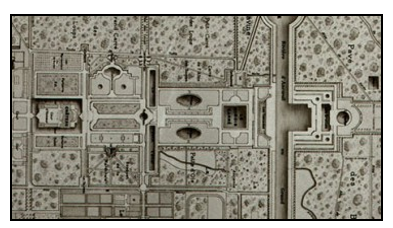
Vaux-Le Vicomte plan.
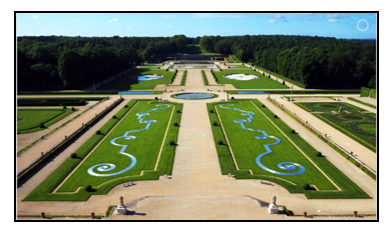
Vaux-Le Vicomte general view.

Vaux-Le Vicomte.
Figure 3.4. Garden of Vaux-Le Vicomte Palace (Vaux- Le- Vicomte, 2019)
Versailles Palace Garden
The Versailles Palace was built between 1661 and 1711, in four separate phases. This palace was planned as a magnificent work to exalt the victory of King Louis, and the most famous architects of the country took part in designing it. The palace garden was designed by Le Notre, the most famous garden artist of France.
The plan of the palace begins in the direction of the town of Versailles in the west. The three different roads coming from the town, from Paris, and from Saint Cloud, merge in the space the king’s statue on horseback stands in the front yard of the palace. Stables and service areas are in front of the face of the palace looking towards the town, while the spectacular, decorative garden is at the back (Korkut et al, 2010), (Figure 3.5).

Garden of Versailles Palace (Alamy, 2020)

Garden of Versailles Palace (Line 17qq, 2010)
Figure 3.5. Garden of Versailles Palace plan.
The design principles and characteristics of the Versailles Palace Garden, which also serves the political and entertainment activities of state authorities, are explained as follows (Erdoğan, 2019), (Figure 3.6):
- The garden sits on echeloned terraces, in a rectangular shape.
- The garden is surrounded by a forest.
- There is a main axis in the center of the garden, with parallel radial roads.
- There is a wide axis right in front of the palace, and there are large scale pools of different shapes on this axis. One of these pools is 1600m in length and 100m in width.
- There are fourteen thousand sprinklers and a large number of statues in these pools in the garden.
- There is a space in the garden, set up to produce exotic plants in winter months, and also orange groves.
- On the upper level of the terraces in the garden are dwarf plants. On the lower levels, besides lemon trees, there are oranges, pomegranates, palm trees, oleanders, and jasmines in pots.
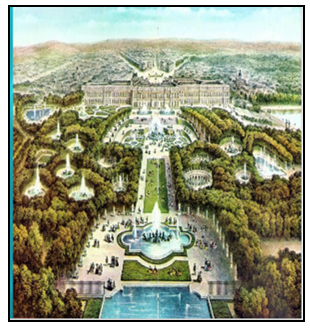
General view.
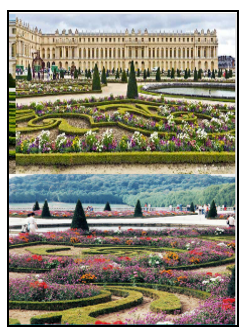
Flower Parties.
Figure 3.6. Garden of Versailles Palace (Erdoğan, 2019)
The effect of French Baroque Gardens on Europe and other countries
The garden samples which appeared in France, and the books published by Le Notre, who was one of the creators of these samples, contributed to the spread of Renaissance garden art in Europe and in some other countries. The climatic and geographical conditions of other places does not display the characteristics of the Renaissance garden art in depth, but they carry similar qualities. Germany, Russia, Holland, Spain, Austria, and Portugal are some of the countries where the French Baroque garden style is seen. In Turkey, especially in Istanbul, the effects of this style was seen in the design of some palace gardens after the Tulip Period. Some examples of these gardens are (Erdoğan, 2019):
Herrenhausen Palace Garden - Germany:
Herrenhausen Palace garden is one of the most important examples of French Baroque style in Europe. The construction of the garden was done between 1666 and 1714. The garden was created on a flat ground. There are radial roads spreading from the main axis, pools of different types, and herbal elements shaped by pruning in this garden (Erdoğan, 2019), (Figure 3.7).

Garden plan (GardenVisit, 2013)
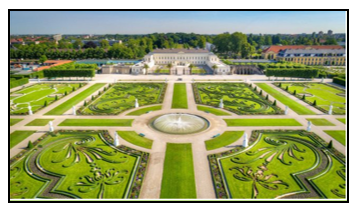
General view (European Historic Gardens, 2020)
Figure 3.7. Garden of Herrenhausen Palace.
Peterhof Palace Garden – Russia:
Accepted as the Versailles of Russia, this garden was built by Petro I. during the 1700s. The garden is in the French Baroque style, with a main axis in the center, and radial roads spreading from it. Besides this, there are pools and herbal elements of different types (Saint Petersburg, 2001), (Figure 3.8).
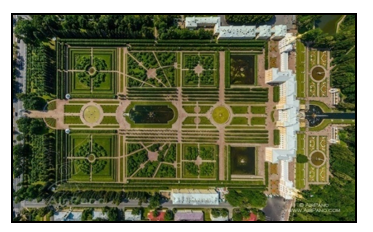
General view.
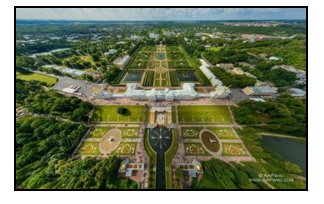
General view.
Figure 3.8. Garden of Peterh of Palace (Airpano, 2020)
Het Loo Palace Garden – Holland:
Het Loo Garden was designed to symbolize the strength of King Stadholder William III and for his wife Paleis Het Loo to host her guests, in the XVII century. At that time, the garden was made up of decorative fountains, symmetrical roaming axes, statues, and flower beds. With the additional arrangements in the XIX century, the garden gained a characteristic of a city park, and this new appearance contradicted its original shape. During this period, serpentine roads, and various plant species, such as woods, bushes, and agro textiles. With a second design and renovation carried out in the 1980s, the park was turned back to its initial French Baroque style. Her Loo Garden gained the status of a botanical garden with the historical plants it houses (Pale Is Het Loo, 2020), (Figure 3.9).

General view.
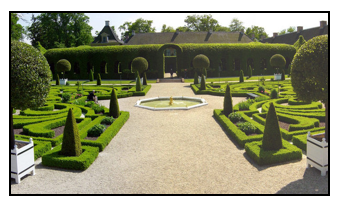
General view.
Figure 3.9. Garden of Het Loo Palace (GardenVisit, 2013)
Queluz Palace Garden – Portugal:
Queluz Garden was designed to be a summer recreation place by King Pedro III, in the XVIII century. The garden is made up of statues, fountains, water falls, water canals, lakes, and various types of herbal elements (WMF, 2012). Damaged to a great extent by a flood disaster in 1984, the garden was restored in 2012 with a planned and controlled work, and given its present day look. During the reconstruction works, it was aimed to give the garden its original look, therefore archeological excavations were carried out. As a result of this work, fountains, statues, and some other decorative elements were reinstated in their original places. Thus, Queluz Garden gained a quality of a fine example to restoration works that can be carried out in historical gardens in Europe (European Heritage Ward, 2018), (Figure 3.10).

Garden plan.

General view.
Figure 3.10. Garden of Queluz Palace (European Historic Garden, 2018)
Beylerbeyi Palace Garden – Turkey:
Beylerbeyi Garden was built for Gevher Sultan, daughter of Sultan Selim II, in the XVII century, and it was one of the most favorite green spaces of the period (Erdoğan & Göke, 2019). In 1734, the garden was redesigned meticulously. It became a place which European travelers talked about with interest and admiration. The garden, which was designed and maintained by foreign gardeners, was made of various sections such as, Harem garden for women, Selamlik garden for men, and Set garden. Beylerbeyi Palace Garden was made of pools, statues, various animals, symmetrical axes, plant in pots, and flower beds. There are also exotic herbal elements in the garden, such as, magnolia, beech, horse chestnuts, elm, cypress trees, and bamboos. Being the only garden in Turkey to reflect the Renaissance garden style with its planning and design principles, Beylerbeyi Palace Garden is an important part of cultural heritage (Mutlu, 2006), (Figure 3.11).
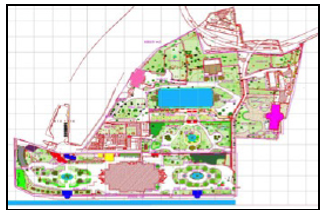
Garden plan.

General view.
Figure 3.11. Garden of Beylerbeyi Palace (Erdoğan ve Göke, 2019)
Conclusion
Throughout history, since the beginning of civilizations, garden art has shown a formation and development, being affected by various perceptives, mainly religion, philosophy, and mythology. The social, cultural, geographical, and physical properties of their specific areas also affected this development. Beginning with antiquity, gardens were designed with functions to display a symbol of power of kings and aristocracy as well as providing recreation for them. Mostly surrounded by borders and closed for public use in those times, in time gardens became public spaces.
The understanding of fearing nature, which prevailed during the Dark Ages, left its place to the idea of loving nature and getting close to it in the Renaissance garden art. Thus, the Renaissance perspective of art is examined under three main characteristics, which are, attitude towards religion, approach towards people, and approach towards nature. Religious teaching being dominant in the pre-Renaissance period, resulted in art showing a religion based development. In the Renaissance style, this perspective was overcome, and a worldly understanding of art related to man appeared. Examined from the point of view of approaching man, the perspective of art based on God left its place for an understanding which put man in the center as subject and criterion. Looking from the point of view of approaching nature, a new approach towards nature gained importance in the Renaissance art style, and it was emphasized that man should dominate nature and get to know it well.
The approach of man shaping nature in the direction of one’s needs, and creating works of art in nature, which prevailed the Renaissance garden art, changed the gardening of previous periods that showed development based on utilitarian gardening. During this period, the need to comprehend nature, interpret it and express, brought about an opening to the environment in garden art, and an integration with nature, and gradually Renaissance gardens were shaped. Gardens that were formed with this perspective were mostly bordered by forest areas and were opened to the environment through wide view terraces.
Renaissance garden art showed formation first in and around Florence, which was the center of rich art, culture, and business of the period in Italy. The formation, change, and development of Renaissance garden art is examined in three periods. The first one is the Florence Villas period. Simplicity and clarity is generally dominant in the gardens of this period. After this, the Architects Period, during which more elaborated, visually rich gardens in which statues and terraces were used abundantly appeared, in contrast to the previous gardens. The Baroque Period in which grandeur, ornamentation, and detail is dominant, and is accepted as a forward step in the Renaissance garden art, is accepted as the third period.
Renaissance garden art has a formal and symmetrical plan as a basis. Statues, water elements, terraces, and plants that can be shaped by pruning were used in concentration. In addition, labyrinths, herbal elements in large earthenware pots were the characteristics of Renaissance gardens. With the effects of its impressive features, plans and forms, Renaissance garden art covered all of Europe and spread in many countries all over the world.
It can be said that garden styles that appeared with the Renaissance garden art have an admirable quality with its highly aesthetic, and planned quality rarely seen in present day gardens. It is possible that present day gardens are affected by these styles and showed development in that perspective, because historical applications always shed light on contemporary ones and form a basis. As in other branches of art, a development and renewal takes place in garden art affected by contemporary conditions. Therefore, it is of great importance to research and examine historical garden styles and include them in designs in contemporary landscape planning.
Historical gardens were formed and developed with various different approaches of style and have reached a quality of becoming inspirational sources for present day garden designs. At the same time, historical gardens are of importance as cultural values. Protection and preservation of these gardens with their identities, characteristic structures, and subjectiveness, and passing them on to future generations is an important duty and responsibility.
